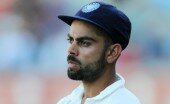Cricket’s Troubled Geniuses: A Review of “Bishan” and “Golden Boy: The Bad Old Days of Australian Cricket”
Written by Alok // December 1, 2011 // Sport // No comments
Imagine Lord’s on a brilliant summer’s day, bathed in soft, golden sunshine.
At the batting crease is a lithe figure with golden curls tucked under a baggy green, ready in his stance, bat tapping on the pitch waiting impatiently for the bowler at the other end. At the other end, a slightly tubby figure with a brilliant blue patka who takes a few smooth steps between the umpire and the stumps and in a perfect, almost seamless action delivers a ball that spins in the air and gently curves into the batsman. The batsman flies out of the crease, and in less time than the blink of an eye, reaches the spot where the ball is about to land, bringing the bat down in a smooth curve making contact with the ball producing a sound akin to a champagne cork being popped, dispatching the ball into the cover boundary for a four, going down on one knee as he completes the stroke. The crowd go wild with delight and even the bowler stands applauding at the genius stroke play.
The lithe batsman is once again at the crease and the patka-bedecked bowler has the ball in his hands once again. Another smooth run up and, seemingly without any discernable change in his action, he releases the ball from seemingly the same spot as he did before; just like the ball that was dispatched to the boundary. Except, this is a little shorter but the batsmen spots it and adjusts, rocking back to get into position to cut the ball to the point fence. Except, he can’t as by the time the bat is even half way down the curve, the ball has taken the top of off stump at blistering pace that no one watching could have predicted of the bowler. It takes a few seconds for the batsman to realize he’s been had – the ball wasn’t as short and he should have been forward not back. He smiles as he tucks his bat under his arm and walks away to the pavilion giving an almost imperceptible nod to the bowler’s genius.*
******
By the reckoning of any cricketing aesthete, Kimberly John Hughes and Bishan Singh Bedi count as the two most graceful and aesthetically brilliant players to have ever graced a cricket field. Apart from their aesthetic skills as cricketers, they share quite a few common attributes. Both came from, relatively speaking, cricketing backwaters (West Australia and Delhi/Punjab respectively) that over the course of their careers became cricketing powerhouses in their respective countries. Both were shy young men whom cricket helped to become gregarious outgoing men. Both were marked out for captaincy fairly early on in their careers. Both had enormous tussles with their respective administrations and figures of authority. Both made bitter enemies of colleagues and fellow teammates.
It is probably no surprise that two entirely fascinating biographies have been written about them by Christian Ryan and Suresh Menon respectively.
Hughes is really remembered for two wildly different things; his flashy and brilliant strokeplay that could tear bowling attacks apart in a matter of minutes, and the famous image of him breaking down in tears as he read out the announcement quitting as Australia’s Test captain. The two are not entirely unrelated, and Ryan’s story brings out very clearly a tale of a boy (a Peter Pan like figure, he never seems to “grow up”) who wanted to bat gloriously in a manner that would bring joy to the cricketers and to himself. Yet, his boyish enthusiasm and elan clashes discordantly with the dominant “Aussie way” of grit over clamour and never putting oneself above the team.
The prime villains in Christian’s narrative are those old bullies; Dennis Lillee and Rod Marsh (and to some extent, Ian Chappell). The casus belli being the appointment of Hughes as captain over the more deserving Marsh in 1982. A tiff that was perhaps exacerbated by the fact that Hughes never seemed to be one of the “blokes” who fit into the dominant ideas of manhood and masculinity that seemed to pervade in Australia’s cricketing culture then. Much as Hughes wanted to be liked and loved by all, he seemed to meet with nothing but open hostility from Lillee and Marsh, leading to such unsavoury sights as the fast bowler trying crack his captain’s skull with bouncers in the nets.
Ryan’s narrative is all the more remarkable since it has been pieced together almost entirely through “secondary evidence” as lawyers would call it. The protagonist and the antagonists, though reconciling and becoming good friends later in life, did not go on record with Hughes for the book. We get insights and accounts from other players in the squad, families, friends, and ghosted autobiographies. For all the talk of “for the team” and “the boys” we get an insight into those times when a team stands divided against itself, and what that can lead to. It is perhaps no surprise that all these events co-incided with “Packer’s Circus” and the lowest ebb of the Australian cricket team as a Test Playing nation. Perhaps Simon Katich’s near throttling of Michael Clarke over a silly tiff after losing the series to South Africa is probably was also a similar symptom.
We are left with a few questions unanswered at the end of the book. Under a more supportive captain (as Bedi found in Pataudi) and in a friendlier atmosphere would Hughes have blossomed into a modern great instead of becoming yet another instance of an attractive batsman whose claim to greatness is belied by his poor numbers? Or would he have continued to play in a cavalier fashion putting attractive play over “the team”. Skill and talent with bat he had aplenty as this innings and this innings will put beyond doubt, but did he have that oft spoken, yet nonetheless vital, quality: temperament. His record speaks for itself.
Bedi, on the other hand, entirely lived up to his potential and more, finishing as India’s highest wicket taker. No less than Don Bradman found Bedi the only left arm spinner who could keep the peerless Wilfred Rhodes company in the Hall of Greats. A classical off-spinner if there ever was one, even in grainy youtube videos, Bedi’s grace and beauty in action as he bowls takes your breath away. He mesmerized batsmen with his control and variations, depending on everything from the tip of his fingers to the position of his toes and everything in between to send down those subtle variations that would be just a little bit faster or a little slower or spin a little more or a fraction less than the previous ball without any obvious change in action.
Menon’s work is more in the nature of an authorized biography as it almost unabashedly presents Bedi’s view in all his battles. And Bedi’s had plenty of battles. From accusing John Lever of using Vaseline in India to get swing (and losing a lucrative county contract in the process) to being perhaps the only serious cricketer to continue to accuse Muttiah Muralidaran of “chucking”, Bedi’s never been afraid of speaking his mind on an issue and facing the consequences. Menon gives us the image of an uncompromising man who never compromised on the principles that underlie cricket (fairplay, sportsmanship and gentlemanly behaviour) even at the risk of defeat and censure. He never seemed to care if his decisions were popular or approved by India’s notoriously incompetent and insecure BCCI members – at least that’s what Menon wants us to believe.
On all points we only get one voice, Bedi’s. Did Bedi meet with resistance when he called off India’s innings early in protest against West Indies’ short pitched bowling? Did no one suggest wiser counsel when he accused Lever of ball tampering? We never know as only side of the story is spelt out. These silences leave the reader with a feeling of something missing as we see the fascinating portrait of a cricketer being drawn in words. Perhaps, as Cromwell told his portrait painter, Menon should have gone “warts and all”. Instead, even the slightest hint of acne is daubed over.
Ryan’s book is by far the better work. Not to belittle Menon’s work but in terms of the research on its main character, the story weaved around Hughes’ life and the writing style wise, Ryan far outstrips Menon.
Plus, it has pictures. Where “Golden Boy” is replete with black and white, and gorgeous techni-colour photos of Hughes in his pomp, “Bishan” is sadly bereft of everything but a single portrait of Bedi in his sixties. Perhaps it was the costs involved but Bishan seems like an infinitely poorer book (pun intended) for the absence of photos of its subject in action – an omission on par with a book on Michelangelo not having a single picture of the Sistine Chapel or David.
While Menon tries hard not to fall into the traditional Indian trap of turning autobiographies into hagiographies, the width of sources that Ryan uses and weaves into the narrative almost ensures that his biography is anything but. Menon’s Bedi is a Sikh warrior with a red leather ball who fights with honour, dignity and in the spirit of sportsmanship, even if he doesn’t win all his battles. Ryan’s Hughes is a complex and conflicted character who, much as he tried to bring joy to others with his cricket, saw himself steadily losing joy in playing cricket with some of his tempestuous teammates. Only one of these descriptions comes close to producing a true picture of the subject.
Yet, when we compare the players themselves emerging from these books, the similarities seem to outweigh the differences. Both were undoubtedly geniuses hell-bent on charting their own respective paths in life. Both refused to compromise on the art in favour of the grit. Bedi would not bowl flatter and faster to suit one day cricket and Hughes disdained the work of plodding strokelessly at the crease. Both careers came to a somewhat premature end. Bedi’s career ended at age 32 in Pakistan as the famous Quartet was torn apart by Pakistani batsmen and Hughes career ended at the age of 30 within a year of him giving up captaincy by a string of poor scores in 1984. Bedi’s running battles with the administrators were matched by Lillee and Marsh’s constant needling of Hughes. Yet, where Bedi lashed out and survived, Hughes did not.
However, where Bedi ended a full and varied career giving him a pride of place in India’s cricketing pantheon, Hughes’ career ended with far too many what-might-have-beens.
Bedi continues to be a popular, if controversial figure in Indian cricket; offering anecdotes, analysis and generous help to all comers.
Hughes is all but forgotten in Australia.
___________
*Apologies to Neville Cardus



